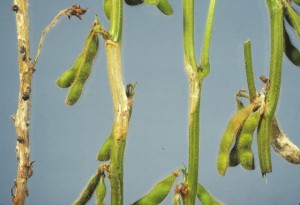Quinn Watson, Plant Pathology, UW-Madison
Damon L. Smith, Plant Pathology, UW-Madison/Extension, (608) 262-5716, dlsmith26@wisc.edu
What is Sclerotinia Stem Rot?
Sclerotinia stem rot (SSR), also known as white mold, is a serious and often lethal fungal disease of many different plants in the North Central U.S., especially soybean. SSR of soybean arises from infection by the fungus Sclerotinia sclerotiorum. Cool, moist environments favor SSR development, with the most severe epidemics found in soybeans that have dense, fast, growing canopies, in high yielding environments.
What does Sclerotinia stem rot look like?
Sclerotinia stem rot causes immediate wilting of leaves and plant death. In addition, bleaching occurs along the base of the stem and in more moist conditions, white cottony mycelial growth occurs. If the infected area is broken open, small black survival structures called Sclerotia can be found.
Where does Sclerotinia stem rot come from?
Sclerotinia sclerotiorum overwinters in dead plant material as small survival structures called Sclerotia. Sclerotia can survive prior to germination for up to 3-5 years in soil. Overall, cool and moist environments favor SSR development from sclerotia. During periods of wet, cool or humid weather, Sclerotinia germinates in two ways. The first is through the production and release of airborne spores over a period of several days from mushroom-like structures called apothecia. The spores can be spread by wind, insects, or rain splash, and colonize the surfaces of dead or declining plant material, like flower petals or leaves. From the initial colonization, SSR soon spreads to healthy plant material. The second manner of SSR proliferation is from direct plant contact and exchange of fungal growth present either on neighboring infected plants or from the soil.
How do I save plants from Sclerotinia Stem Rot?
SSR is difficult to control once the disease has manifested. Fungicide application after infection will not cure a symptomatic plant of the disease. Research has demonstrated that application of fungicide to control Sclerotinia stem rot is most successful at the R1 growth stage and less successful at the R3 growth stage. Fungicide application after R3 is not recommended, as the risk for new infections is very low after flowering is complete.
How do I avoid problems with Sclerotinia Stem Rot in the future?
There are several methods that can aid in reducing or preventing SSR in fields with a history of the disease. Overall the most economical and long-term approach is to use cultivars of soybeans bred for resistance to Sclerotinia stem rot. Other options include using clean seeds that
do not have any visible, small black Sclerotia. Planting with wide row spacing (30”) and avoiding high plant populations (> 175,000 plants per acre) to allow plenty of air circulation can also help reduce the incidence of SSR. Fields should be well drained and excessive irrigation should be avoided. Heavy fertilizer application that can result in vigorous, bushy plants should be avoided. A dense plant canopy can promote Sclerotinia stem rot. Soil tests should be conducted regularly in order to maintain adequate fertility and to reduce the risk of over fertilization. For fields that have Sclerotinia present, deep tillage has been shown to reduce Sclerotinia stem rot severity. Rotations of 2-3 years between soybean crops can help reduce the level of Sclerotinia stem rot in fields. Using corn or small grains crops such as wheat, barley, or oats in rotation with soybean is recommended.
Furthermore, there are fungicides that can help reduce infections in a field. Fungicides effective in controlling Sclerotinia stem rot can be found in the accompanying table (use the column labeled “White Mold”). As mentioned previously, the best time to treat for Sclerotinia stem rot is at the R1 growth stage. Studies have demonstrated that successful control of Sclerotinia stem rot using fungicides is greatly reduced when they are applied after symptom development or at the R3 growth stage. Fungicide application after R3 is not recommended, as the risk for new infections is very low after flowering is complete.
Biocontrol agents are also available, the most effective being Coniothyrium minitans. Coniothyrium minitans is incorporated into the soil and attacks the sclerotia (survival structures) of Sclerotinia sclerotiorum. The application of Coniothyrium minitans will not eliminate all sclerotia. Furthermore, it takes time for Coniothyrium minitans populations to build up in the soil; as a result it can take time before favorable results are observed.
To download a full PDF of this article HERE.
More information on Sclerotinia stem rot:
Sclerotinia Stem Rot Review: Biology, Yield Loss, and Control of Sclerotinia Stem Rot of Soybean
Management of White Mold in Soybeans Podcasts, by North Central Soybean Research Program





